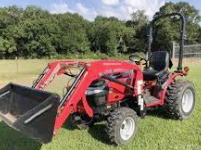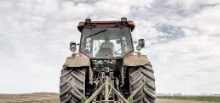________________________________________________________________________________________
| Home / Farm Tractors / Mahindra Tractors / Mahindra Max 26XL |
Mahindra Max 26XL Troubleshooting
 The
Mahindra Max 26XL is a 4WD compact utility tractor from Max Series. This model
was manufactured from 2014 to 2019. The Mahindra Max 26XL tractor is powered by
80.4 cu.in (1.3 L) Mitsubishi S3L2 4-stroke 3-cylinder indirect injection
naturally aspirated diesel engine with a rated power of 25.5 Hp (19.1 kW). The
Mahindra Max 26XL is fitted with a two transmission options: synchro shuttle
transmission with 8 forward and 8 reverse gears, or 2-range hydrostatic
transmission with infinite forward and reverse gears.
The
Mahindra Max 26XL is a 4WD compact utility tractor from Max Series. This model
was manufactured from 2014 to 2019. The Mahindra Max 26XL tractor is powered by
80.4 cu.in (1.3 L) Mitsubishi S3L2 4-stroke 3-cylinder indirect injection
naturally aspirated diesel engine with a rated power of 25.5 Hp (19.1 kW). The
Mahindra Max 26XL is fitted with a two transmission options: synchro shuttle
transmission with 8 forward and 8 reverse gears, or 2-range hydrostatic
transmission with infinite forward and reverse gears.
The maximum travel speed (forward/reverse): 11.2 mph (18 km/h) and 9.4 mph (15.1 km/h). The open center hydraulic system has a gear pump with a rated capacity of 5.8 gpm (22 lpm). The tractors are equipped with 7.00x12 front tires and 9.50x16 rear tires. The wheelbase is 63.2 inches (1605 mm). Compatible attachments for the tractor: 60" mid-mount 3-blade side discharge Mahindra 65M mower deck with cutting height of 1-4" (25-102 mm), Mahindra Max 26L front end-loader with a maximum lift height of 82.7" (2100 mm), and Mahindra 26B backhoe with maximum digging depth of 80" (2030 mm).
| Diesel Engine Troubleshooting |
| Engine starts up hard or won't start |
Air in fuel tank - Bleed fuel tank.
Fuel filter element is dirty - Clean or replace the filter.
Defective injection nozzle - Replace injection nozzles.
Water or dirt in fuel system - Drain, flush, and service the system.
The valve clearance is not adjusted - Check and adjust as required.
Defective fuel injection pump - Replace or rebuild injection pump.
| Diesel starts but immediately shuts off |
Clogged air cleaner - Clean or change.
Fuel filter element clogging - Clean the filter element.
Problems with fuel injection pump tightness - Inspect fuel injection pump for leaks.
Fuel injectors are dirty or defective - Change or clean fuel injectors.
Fuel injection pump damage - Repair or change injection pump.
| Engine stalls after running |
Engine not warmed up - Warm up to required temperature.
Fuel filter element is dirty - Service the filter.
Air in the fuel system - Air bleeding.
Fuel injection nozzles are clogged or faulty - Replace injection nozzles.
Wrong setting of fuel injection pump timing - Set the fuel pump timing correctly.
| Engine stops while idle |
Low idle speed set incorrectly - Correct low idle adjustment.
Fuel injection pump is not working correctly - Replace injection pump or repair it.
Damaged or clogged injectors - Replace or clean fuel injectors.
Valve clearance is wrong - Adjust valve clearance.
| Lack of engine power |
Air filter clogged - Install new air filter element.
Faulty fuel injection nozzles - Replace injection nozzles.
Incorrect fuel injection pressure - Adjust to proper pressure.
The valve clearance is incorrect - Correct valve clearance needs to be set.
Wrong adjustment of low idle speed - Correct low idle adjustment.
Clogged fuel hoses or lines - Clean fuel system lines and hoses.
Blown cylinder head gasket - Gasket should be replaced.
Piston rings are leaking or defective - Replace piston rings.
| Engine overheating |
Not enough coolant - Add coolant and check the components of cooling system.
Engine oil level is insufficient - Need to add engine oil.
Defective radiator cap or clogged radiator fins - Change cap or clean radiator.
Damaged or worn fan belt - Fan belt must be replaced.
Engine overload - Reduce the load or use a lower gear.
| Low oil pressure |
Oil level is low - Need to add oil.
Dirty oil filter - Replace or clean engine oil filter element.
Incorrect oil viscosity - Use oil of proper viscosity.
Incorrect oil clearance in main bearing - Bearings need to be reinstalled.
Oil pump is defective - Check and replace if necessary.
| Engine noises or knocks |
Engine oil insufficient - Fill up the engine oil.
Engine is not preheated - Warm up to required temperature.
Fuel injection pump timing is not adjusted - Adjust as recommended.
Low idle speed setting is not correct - Normalize low idle speed.
Fuel injectors are dirty or defective - Replace or clean fuel injectors.
Misaligned or defective connecting rod Need to replace or align the connecting rod.
Pistons are broken or worn - Pistons replacement required.
| Transmission Troubleshooting |
| Low transmission pressure |
Transmission oil insufficient - Check transmission oil level and add oil as required.
Transmission oil filter is dirty (if equipped) - Clean or change transmission oil filter.
Stuck relief valve - Install a new valve.
| Transmission noise |
Lack of transmission oil supply - Add oil to the transmission housing.
Transmission oil is contaminated - Transmission oil change required.
Incorrect backlash or gears are worn - Adjust backlash correctly or replace the gears.
Bearings are broken or worn - Install new bearings.
Damaged or worn gear shift forks - Replace the shift forks.
Shaft splines are damaged or worn - Install a new shaft.
| Difficult to shift gears |
Gear shift linkage is worn or rusty - Lubricate or replace the shift linkage.
Worn or bent gear shift forks - Replace the shift forks.
Gearshift mechanism malfunction - Identify and replace failed parts.
Clutch is faulty or misadjusted - Clutch adjustment or replacement required.
| Transmission fluid leaking |
Transmission oil level is exceeded - Correct the oil volume.
Damaged seals or gaskets - Change defective gaskets or seal.
| Hydrostatic Transmission Troubleshooting |
| Hydrostatic transmission is making noise |
Low transmission oil level or contaminated oil - Change transmission oil or top up to proper level.
Worn or out of adjustment speed control linkage - Adjust or change linkage.
Defective relief valve - Install a new relief valve.
Transmission overload - Reduce the load is required.
Defective or worn transmission parts - Check internal transmission parts for damage or wear and replace if required.
| Loss of power |
Transmission fluid level is low - Fill the transmission housing to proper fluid level.
Defective relief valve - Replace relief valve.
Speed control pedal linkage is damaged or out of adjustment - Adjust or install new linkage.
| Transmission oil over heats |
Transmission fluid insufficient - Fill the transmission housing to proper fluid level.
Transmission oil filter is clogged - Clean or change transmission oil filter.
Cooling components are defective or plugged - Check all cooling components and clean or replace if required.
Excessive loading - Load needs to be reduced.
| External fluid leaks |
Damaged gaskets or seals - Install new gaskets or seal.
Internal transmission housing pressure is too high - Change defective parts.
Clogged transmission fluid return pipe - Clean or change return pipe.
| Hydraulic System Troubleshooting |
| Hydraulic oil pressure is low |
Low hydraulic fluid level - Checking hydraulic fluid level and add if necessary.
Hydraulic oil filter is clogged - Change the hydraulic filter element or service if required.
Damaged hydraulic pump - Change or repair hydraulic oil pump.
Hydraulic control valve block is set improperly - Set properly.
Faulty hydraulic cylinder - Change or repair hydraulic cylinder.
Leaks in hydraulic lines - Inspect the system for leaks and fix it.
| Excessive hydraulic system heat |
Faulty main relief valve - Relief valve must be changed.
Improper type of hydraulic oil - Use the proper type of oil.
Hydraulic fluid contamination - Change hydraulic fluid.
Air in the hydraulic system - Air bleeding.
| Hitch won't raise or raises slowly |
Excessive load on hitch - Reduce hitch load.
Hydraulic oil is insufficient - Checking hydraulic oil level and add if necessary.
Clogged hydraulic oil filter - Replace filter element or clean if required.
Hydraulic pump failure - Change or repair hydraulic oil pump.
Defective main relief valve - Replace relief valve.
Hydraulic control valve is faulty - Install a new valve or repair it.
Hydraulic cylinder is broken - Change or repair hydraulic cylinder.
Suction line is broken or disconnected - Connect or replace.
| Hitch fails to drop or drops slowly |
Hydraulic control valve block is out of adjustment - Control valve needs to be adjusted.
Defective hydraulic cylinder - Replace or repair hydraulic cylinder.
Hitch is out of adjustment - The three-point hitch must be adjusted.
Hitch cross shaft is worn - Change the shaft.
| Hitch drop or lift is jerky |
There is air in the hydraulic system - Bleed hydraulic system.
Contaminated hydraulic oil - Change hydraulic oil.
Defective hydraulic pump - Change or repair hydraulic fluid pump.
Damaged hydraulic spool valve - Replace or repair the valve.
Hydraulic cylinder is broken - Replace or repair hydraulic cylinder.
| Steering System Troubleshooting |
| Excessive effort to steer |
Improperly assembled or defective steering column - Reassemble or change the steering column.
Air in the hydraulic steering system - Air-bleed steering system.
Improper toe-in - Check and adjust toe-in.
Tire pressure uneven - Inflate the tires correctly.
Steering pump failure - Repair or change steering pump.
Pump flow control valve is stuck or worn - Flush or change flow control valve.
Insufficient steering oil - Need to add steering oil.
| Excessive free play of steering wheel |
Steering column coupling or shaft is extremely worn out - Replace faulty part.
Steering pump failure - Install a new steering pump.
Steering linkage components are loose or worn - Change or repair steering linkage.
| Front wheels wander to left or right |
Tires have uneven wear - Replace the tires.
Improper toe-in - Adjust toe-in wheels.
Steering linkage components are loose or worn - Repair or replace steering linkage.
Incorrectly adjusted or worn front wheel bearings - Install new bearings or adjust it correctly.
| Electrical Troubleshooting |
| Battery does not charge |
Loose or corroded wire connections - Tighten or service cable connections.
Faulty battery terminal clamps - Replace terminal clamps.
Worn-out battery - Use a new battery.
Worn or loose belt - Need to adjust belt tension or replace belt.
| Starter turns slow |
Battery voltage is low - Battery is drained, charge it.
Battery runs out quickly - Service battery or replace it.
Corroded battery terminals or disconnected wires - Check cable connections and replace or service terminals.
| Starter motor is not working |
Battery is low or faulty - Recharge or change battery.
Battery cables are disconnected or improperly connected - Inspect cables and connect properly.
Low battery voltage - Battery is drained, recharge it.
Starter motor is defective - Repair or replace starter.
________________________________________________________________________________________
________________________________________________________________________________________
| Farm Tractors Technical Specifications |
